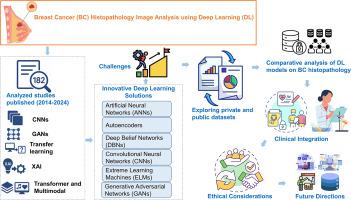基于深度学习的乳腺癌组织病理学图像分析综述:挑战、创新和临床整合
IF 4.2
3区 计算机科学
Q2 COMPUTER SCIENCE, ARTIFICIAL INTELLIGENCE
引用次数: 0
摘要
乳腺癌(BC)是女性中最常见的癌症,也是全球癌症相关死亡的主要原因。准确和及时的诊断对于改善患者预后至关重要。然而,传统的组织病理学评估是劳动密集型和主观的,导致观察者之间的差异和诊断不一致,特别是在资源有限的情况下。此外,组织染色的可变性、标准化注释数据集的有限可用性以及微妙的形态模式使肿瘤的一致性特征复杂化。深度学习(DL)最近成为乳腺癌病理学的一项变革性技术,为组织病理学图像的癌症检测、分类和分割提供了自动化和客观的解决方案。本文系统地评估了先进的深度学习(DL)架构,包括卷积神经网络(cnn)、生成对抗网络(gan)、自动编码器、深度信念网络(dbn)、极限学习机(elm)和基于变压器的模型,如视觉变压器(ViTs),以及迁移学习、基于注意力的可解释人工智能技术和多模态集成,以解决这些诊断挑战。我们分析了199篇参考文献,包括182篇2014年至2025年间发表的同行评议研究,以及17个知名的在线资源(网站、数据库等),确定了未来研究的关键创新、限制和机会。此外,我们探讨了合成数据增强、可解释人工智能(XAI)和多模式集成在增强临床信任、模型可解释性和诊断准确性方面的关键作用,最终促进个性化和高效的患者护理。本文章由计算机程序翻译,如有差异,请以英文原文为准。

A review of breast cancer histopathology image analysis with deep learning: Challenges, innovations, and clinical integration
Breast cancer (BC) is the most frequently diagnosed cancer among women and a leading cause of cancer-related mortality globally. Accurate and timely diagnosis is essential for improving patient outcomes. However, traditional histopathological assessments are labor-intensive and subjective, leading to inter-observer variability and diagnostic inconsistencies, especially in resource-limited settings. Furthermore, variability in tissue staining, limited availability of standardized annotated datasets, and subtle morphological patterns complicate the consistent characterization of tumors. Deep learning (DL) has recently emerged as a transformative technology in breast cancer pathology, providing automated and objective solutions for cancer detection, classification, and segmentation from histopathological images. This review systematically evaluates advanced deep learning (DL) architectures, including convolutional neural networks (CNNs), generative adversarial networks (GANs), autoencoders, deep belief networks (DBNs), extreme learning machines (ELMs), and transformer-based models such as Vision Transformers (ViTs) as well as transfer learning, attention-based explainable AI techniques, and multimodal integration to address these diagnostic challenges. Analyzing 199 references, including 182 peer-reviewed studies published between 2014 and 2025 and 17 reputable online sources (websites, databases, etc.), we identify key innovations, limitations, and opportunities for future research. Furthermore, we explore the critical roles of synthetic data augmentation, explainable AI (XAI), and multimodal integration to enhance clinical trust, model interpretability, and diagnostic precision, ultimately facilitating personalized and efficient patient care.
求助全文
通过发布文献求助,成功后即可免费获取论文全文。
去求助
来源期刊

Image and Vision Computing
工程技术-工程:电子与电气
CiteScore
8.50
自引率
8.50%
发文量
143
审稿时长
7.8 months
期刊介绍:
Image and Vision Computing has as a primary aim the provision of an effective medium of interchange for the results of high quality theoretical and applied research fundamental to all aspects of image interpretation and computer vision. The journal publishes work that proposes new image interpretation and computer vision methodology or addresses the application of such methods to real world scenes. It seeks to strengthen a deeper understanding in the discipline by encouraging the quantitative comparison and performance evaluation of the proposed methodology. The coverage includes: image interpretation, scene modelling, object recognition and tracking, shape analysis, monitoring and surveillance, active vision and robotic systems, SLAM, biologically-inspired computer vision, motion analysis, stereo vision, document image understanding, character and handwritten text recognition, face and gesture recognition, biometrics, vision-based human-computer interaction, human activity and behavior understanding, data fusion from multiple sensor inputs, image databases.
 求助内容:
求助内容: 应助结果提醒方式:
应助结果提醒方式:


